In Compton, the fate of a cemetery hangs in the balance
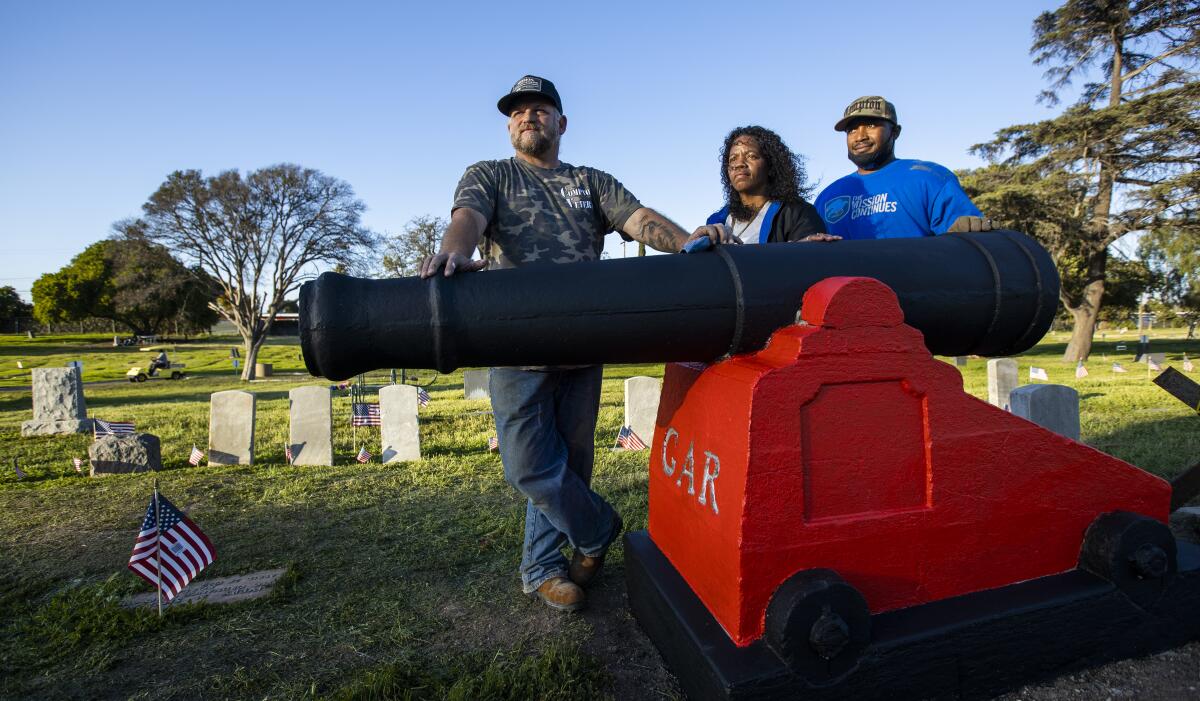
- Share via
Celestina Bishop has been visiting her mother and three sisters at the Compton cemetery since she was 2 years old.
They died on the same day, Jan. 23, 1977, bludgeoned to death in their home. Bishop, the youngest, was spared, left alone with the bodies for two days.
Sometimes, she and her grandmother stayed at the cemetery for so long they fell asleep on top of the graves. Bishop had no memories of her mother and sisters, so she clung to the spot where they were buried.
Now, at 46, she is trying to save the cemetery that is her strongest connection to the family she never knew.
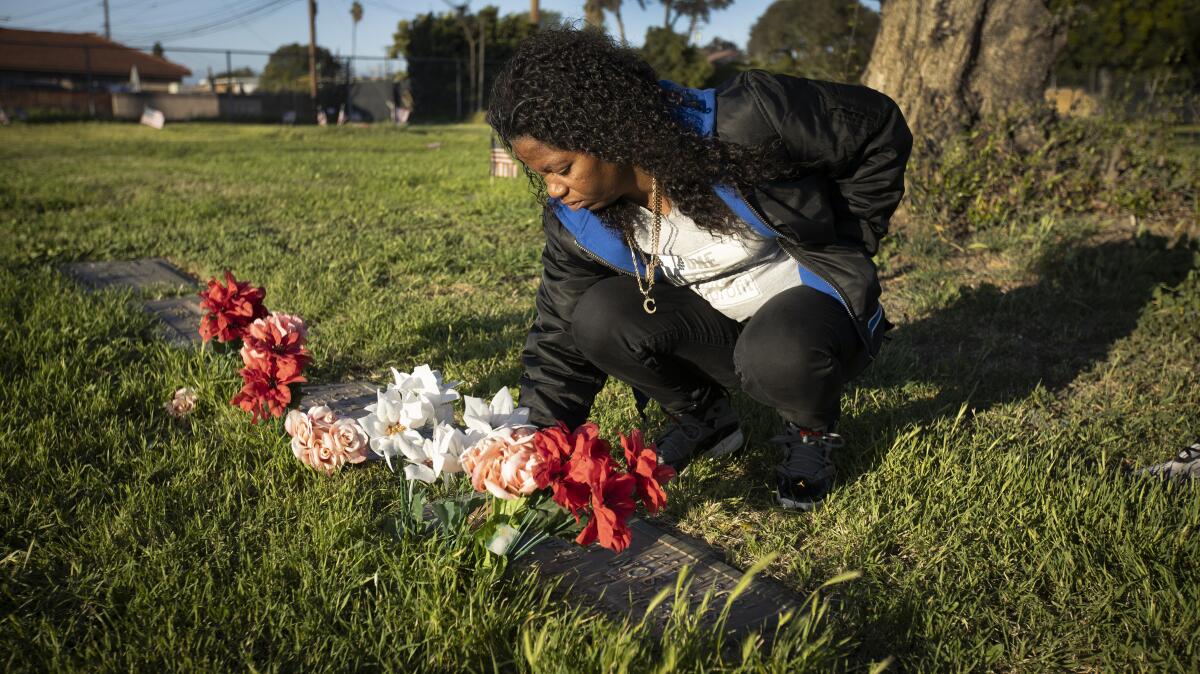
In the last two decades, Woodlawn Memorial Park has careened from disaster to disaster.
It was temporarily shut down in 2000 after bone fragments were found around the grounds and it was discovered that graves had been moved and combined. The owner at the time paid $100,000 to avoid criminal prosecution.
The problems continued with a new owner, Ruben Suarez. He surrendered his license for the cemetery in January 2020 after a state investigator found that the grass was brown, the grounds were covered in weeds, and many grave markers were unreadable. Homeless people and wild animals had moved in, and the gates were locked to visitors, according to Bishop.
Last year on Mother’s Day, after hopping the gates to visit the graves of her mother and sisters, Bishop decided to do something.
She started a nonprofit, One Section at a Time, and has been running the cemetery with the help of volunteers and a small staff. She and her husband, Marvis Jackson, have spent about $230,000 on a new irrigation system, cleaning equipment, trash removal and staff salaries. She has since launched a second nonprofit that benefits the cemetery, Woodlawn Celestial Gardens.
Suarez told her last summer that he wanted to donate the 11-acre property to one of her nonprofits, she said. Then, she discovered that Suarez owed more than $800,000 in property taxes on the cemetery, which is wedged between a residential neighborhood and an industrial area north of the 91 Freeway.
She cannot afford the tax liability, so her dream of taking over the cemetery remains on hold.
“I’m not seeking this property for monetary gain, because I can’t make any money off of it. I’m seeking this property because you cannot treat dead folks like that,” said Bishop, an author and entrepreneur who owns a hair salon and landscaping business and has 11 children.
Founded in 1871, Woodlawn Memorial Park is one of the oldest cemeteries in Los Angeles County.
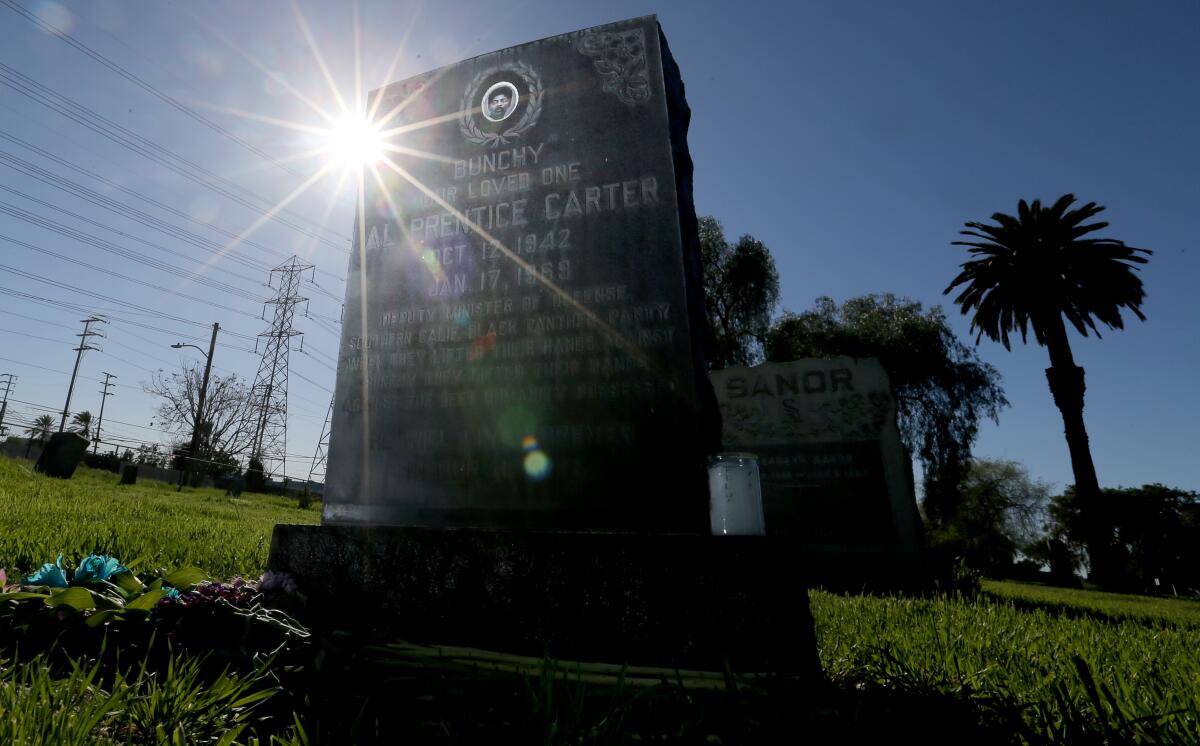
Among the 26,000 or so people buried there are Griffith Dickenson Compton, considered the founder of the city; Francis Townsend, who inspired the Social Security Act of 1935; and Alprentice “Bunchy” Carter, a founding member of the Southern California chapter of the Black Panther Party.
Also at rest there are more than 900 veterans, including 17 unidentified Civil War soldiers from the Union Army.
Prior to the 1950s, Compton was mostly white due to racially restrictive housing covenants. After the U.S. Supreme Court ruled that the covenants were unenforceable, Black families began moving to new housing developments in Compton, said Josh Sides, a history professor at Cal State Northridge and author of “L.A. City Limits: African American Los Angeles from the Great Depression to the Present.”
As Compton became a predominantly Black community in the early 1970s, then an increasingly Latino one, the people buried at Woodlawn reflected the changing demographics.
The violence that took hold in Compton and in nearby South L.A. led to some graves being dug tragically early. In July 1977, a teenage neighbor was convicted of second-degree murder in the killings of Bishop’s mother and sisters in South L.A., according to an account in The Times. Her mother, Billie Collier, was 29; Sonha was 12; Francois, 10; and Desiree, 7.
Inquiry: Human bone fragments and casket pieces are found on the grounds and single-use graves had been converted to multiple burials, officials say.
Suarez bought Woodlawn Memorial in 2011. The situation soon went south, according to a complaint filed in 2019 by then-California Atty. Gen. Xavier Becerra.
Starting in July 2013, Suarez ignored repeated warnings from the state’s Cemetery and Funeral Bureau that he was not adequately maintaining Woodlawn, the complaint said. In 2016, according to the complaint, the bureau ordered the cemetery to stop digging up graves and moving them, while leaving “residual human remains on the surface of previous locations.”
The complaint was resolved in late 2019 after Suarez admitted to the allegations and agreed to surrender Woodlawn’s cemetery license and his cemetery manager’s license. Unlicensed cemeteries can’t hold burials without approval from the Cemetery and Funeral Bureau.
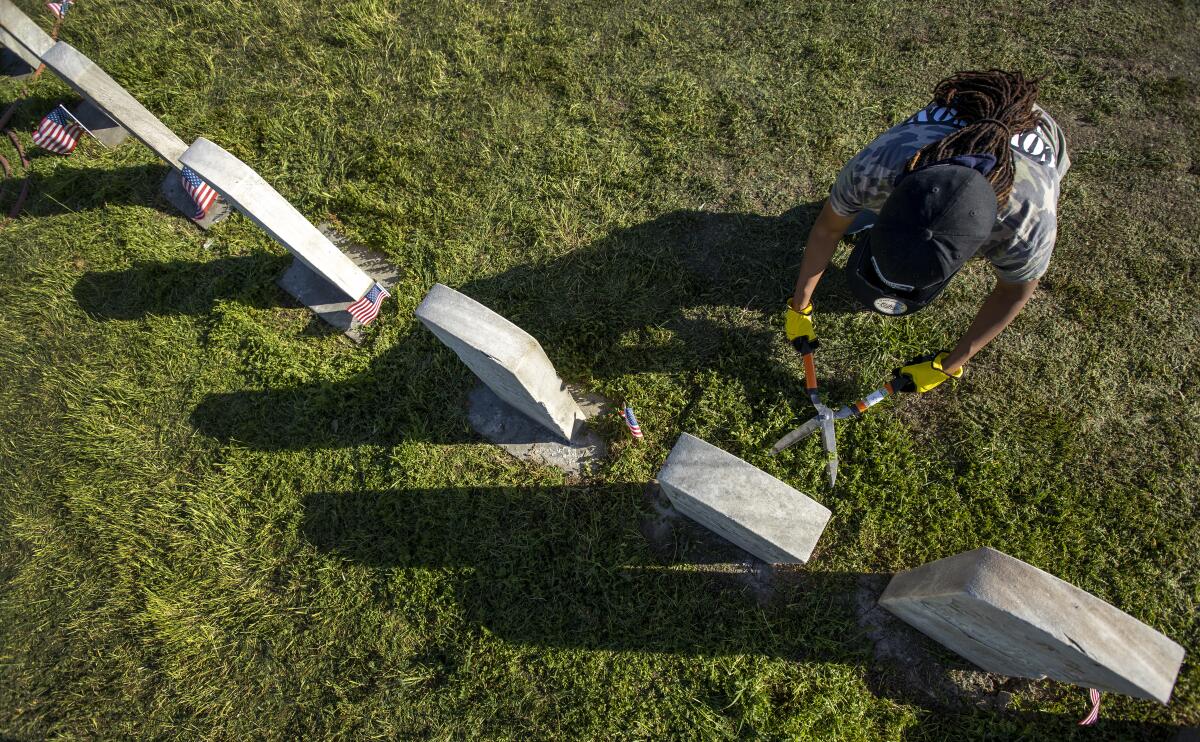
Suarez declined to comment for this report. His attorney Eugene Alkana said Suarez wants to transfer the cemetery to a Bishop nonprofit at no cost.
“It’s a challenge, but it’s not one we haven’t tried to come up with solutions for,” Alkana told The Times in February. Alkana would not specify possible solutions or indicate how his client plans to deal with the back taxes.
The tax bill, now at more than $840,000, continues to increase because of delinquency fees, said Deondria Barajas of the Los Angeles County Treasurer and Tax Collector’s office. Suarez hasn’t made any payments since 2012, Barajas added. The property is now in tax default, making it eligible for auction, a possibility that worries Bishop.
The assessed value of the cemetery is more than $3.5 million. But the true value is likely lower because of its compromised state, said L.A. County Assessor Jeffrey Prang. Suarez could appeal the assessed value, potentially lowering his property tax bill, but he has not done so.
The assessor’s and tax collector’s offices are exploring solutions, officials said.
Compton officials say they would like the cemetery to be in better shape. But because it is privately owned, the city cannot take control of it. And state law prohibits such a large property from being run as a municipal cemetery, said City Atty. Damon Brown.
Encouraged by Bishop, Assemblyman Mike Gipson (D-Carson) in February introduced a bill, AB 651, that would require the appointment of a temporary manager if a cemetery owner loses his or her license. The bill, co-sponsored by the city of Compton, also increases the amount cemeteries must deposit to their endowment funds when they sell a plot.
The legislation would come too late for Woodlawn but is designed to prevent cemeteries from falling into disrepair in the future.
“We lay our family members down here to rest,” said Gipson, who has several cousins buried at Woodlawn. “We expect the cemetery to be kept in such a manner that represents dignity as well as respect.”
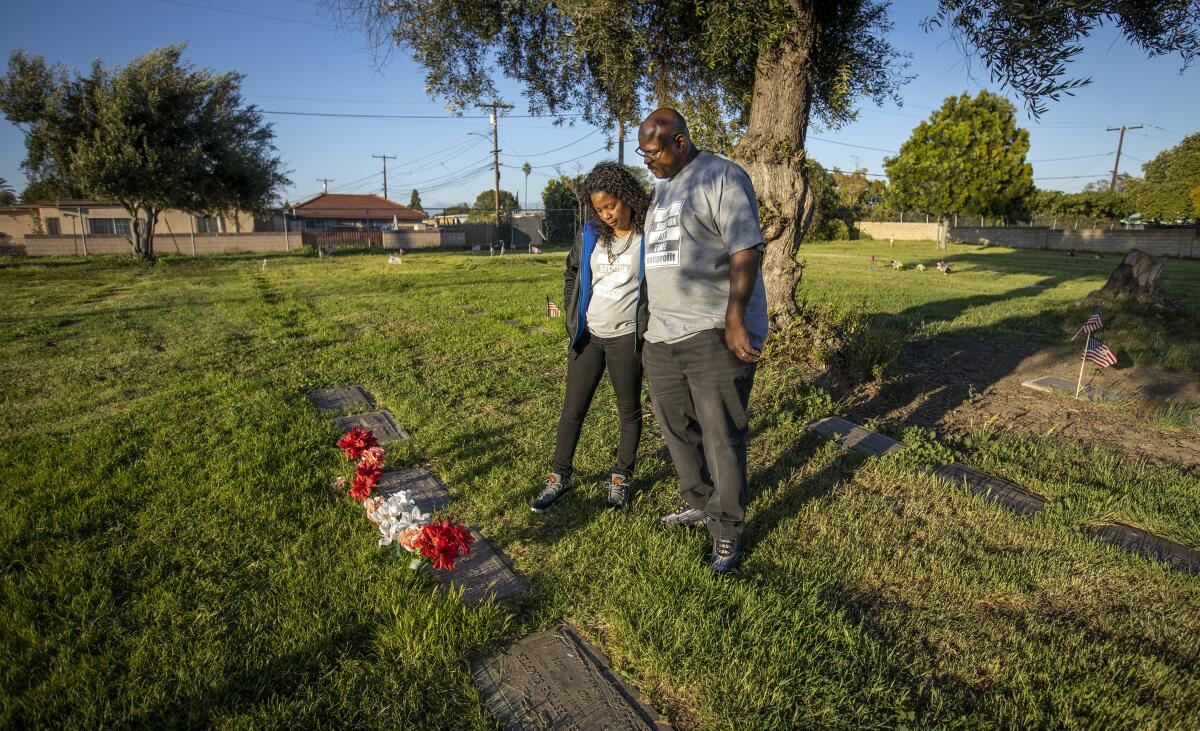
As Bishop’s efforts to care for the cemetery gained steam last summer, hundreds of volunteers joined her at a cleanup event. She documented them raking vegetation, cleaning headstones and picking up loads of trash; a TikTok video has had 1.3 million views.
Now, the grass is green, and most headstones are legible, except for a handful of old ones. But the number of volunteers has dropped over the last several months, said Bishop, who puts in some work at the cemetery seven days a week.
She plans to establish an outdoor museum there, with volunteers hosting tours about the cemetery’s history.
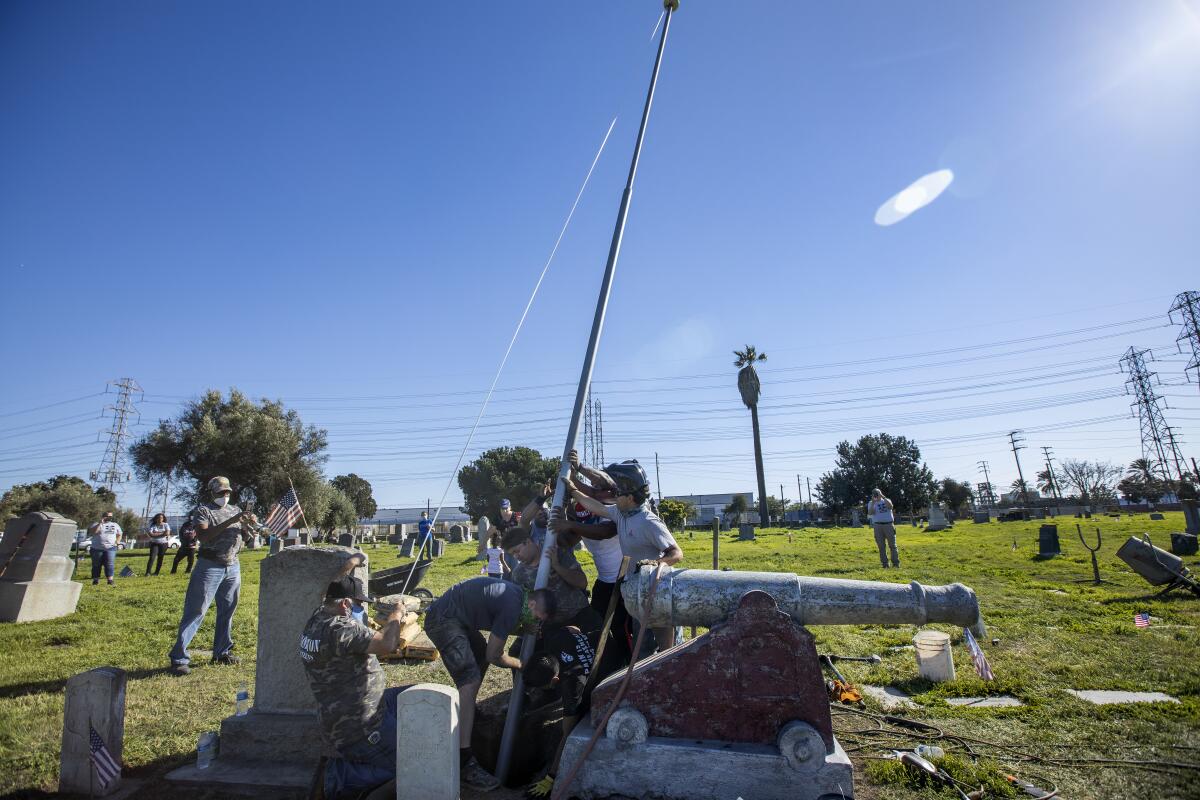
On a recent Wednesday, Ronald Perkins studied each gravestone at Woodlawn Memorial Park, hoping to find three family members.
Perkins, 71, a retired postal worker, hadn’t visited in years, thinking the gates were locked. But that day, the Carson resident drove by and spotted them open. In 10 minutes, he found his paternal grandmother, Mary Perkins, who died in 1975. The mother of eight had worked as a cotton picker in the 1940s in Bakersfield, later moving to Los Angeles and attending church in Compton.

Frank Wilson, part of the fourth generation of his family with roots in Compton, has at least 44 relatives buried at Woodlawn Memorial Park. The oldest is his great-great-grandfather, William Almon Wilson, who in 1857 traveled by wagon train from Missouri to California, landing in San Bernardino and eventually the Compton area, where he raised a large family, according to a local newspaper.
Frank Wilson, who lives in Fountain Valley and is a retired L.A. County probation director, had not visited the cemetery in years and wasn’t aware of its deterioration until he saw a newscast about it last summer. He headed over that same day and has been coming back on Fridays ever since. He is now on the board of One Section at a Time.
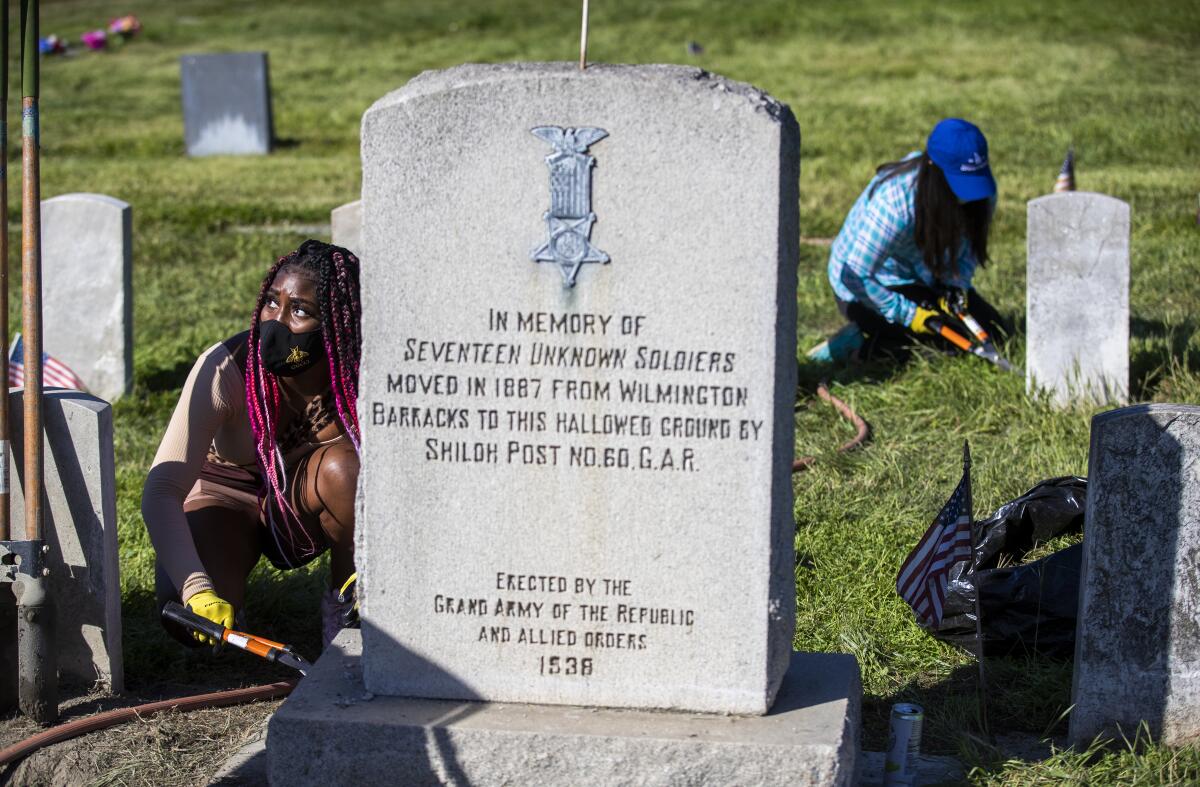
“There have been times when people have been emotional and almost [in] tears that they can finally come in and see their family,” Wilson said.
For Bishop, it was not surprising that her journey would culminate here, as she grew from the toddler victim of a horrific crime to a woman still mourning her mother and sisters.
“It’s knowing what you have been through, knowing what you’re capable of withstanding and remaining solid to yourself,” she said. “That’s a survivor.”
More to Read
Sign up for Essential California
The most important California stories and recommendations in your inbox every morning.
You may occasionally receive promotional content from the Los Angeles Times.














